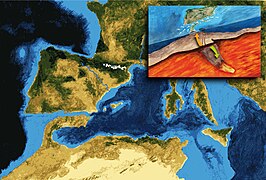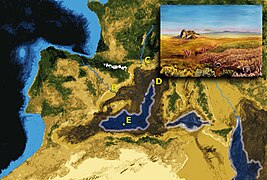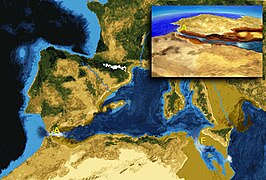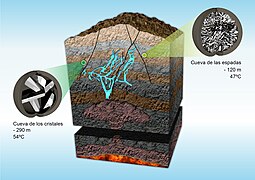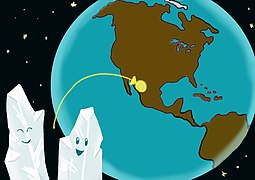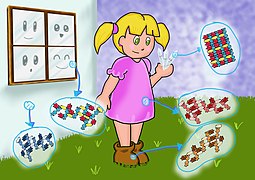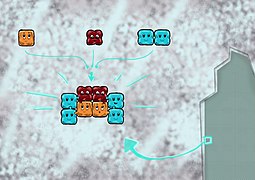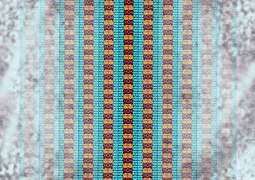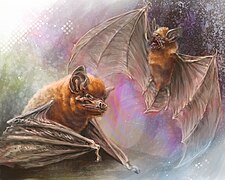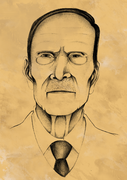VikiArS/Kazostudoj
| Main Page | Get started | Schools | Get involved | Gallery | Case studies | Tips and Resources |
|
Jen listo de kazostudoj priskribantaj specifajn projektojn faritajn de Vikimedio kunlaborante kun artaj kaj dezajnaj lernejoj aŭ edukaj institucioj, inkluzive de trejnao pri farado de grafikaĵoj. Alklaku iujn paragrafojn por pli da informo kaj specifaj projektoj.
La sekiĝo de Mediteraneo kaj la magio de kopilaso  Between 6 and 5.3 million years ago (mya), the Mediterranean Sea dried up after becoming isolated from the Atlantic Ocean. The evaporation of the Mediterranean led to the accumulation of enormous salt deposits on the seabed through a process known as the Messinian salinity crisis, which lasted for 700,000 years and ended with the abrupt re-flooding of the basin after the Strait of Gibraltar was finally breached. Pau Bahí, a Llotja student on internship at Amical Wikimedia during the 2011-2012 academic year, undertook the challenge of representing this process. He was advised by Daniel Garcia-Castellanos, researcher at the Jaume Almera Institute for Earth Sciences (ICTJA-CSIC) and member of Wikimedia España, who provided documentation and corrected and validated the images before they were published. Pau created a series of four images that illustrated the channels that existed prior to the isolation of the Mediterranean (7 mya), the uplifting of Gibraltar and the disappearance of all but one of the channels (6 mya), the complete isolation and desiccation by evaporation of the Mediterranean (5.6 mya), and the re-flooding of the basin (5.3 mya). Letters were superimposed on two of the images, thereby allowing the encyclopedia article or figure caption to make reference to specific parts of the image. To facilitate understanding of the event, Pau included insets in the upper right-hand corner of three of the images of the Mediterranean basin. One of these insets shows what happened under the earth's crust to cause the Mediterranean basin to rise 6 mya: as a portion of the lithosphere dropped down into the mantle, extremely molten magma rose through the cracks in the crust. Another inset shows what the desiccated Mediterranean basin would have looked like, with gerbils and camelids crossing from Africa to the European continent. Pau conducted research and consulted with paleontologists in order to draw these animals. The third inset is meant to complement the bird's eye view of the larger image. Drawn from a lower vantage point, the image shows water cascading through the Strait of Gibraltar on its way to the Strait of Sicily. After the images were validated, Pau uploaded them to Wikimedia Commons and made them freely available with a copyleft license. They are now used on Wikipedia in several languages.
During the following academic year (2012-2013), Federica Brigida, an Erasmus student in the Bachelor's Degree in Advertising and Public Relations at the University of Cádiz, made a video about the salinity crisis by combining Pau's graphics with an animation created by Manolo Mantero and Daniel García-Castellanos (which also had a copyleft license). The video shows an animated recreation of some of the steps in the process. Text and visual indicators were added in order to draw the viewer's gaze to the areas where things are happening. Interspersed between Pau's drawings, Federica added video clips that show what happened underneath the earth's crust. The free licenses on the original materials allowed Federica to create a derivative work, also under the same type of license. This is a good example of how copyleft licenses regulate the creation of new works by combining multiple existing works by different authors. It also shows that Wikimedia Commons, a large repository of freely available files, is an ideal place to search for materials and share results. Explaining the Naica Mine infographically Naica is an underground mine in Mexico that contains lead, silver and other metal deposits. It is best known for its caves containing very large gypsum crystals. Specifically, the mine's Cave of the Crystals contains the world’s largest known crystals. These extraordinarily large crystals were created by a complex process that began when the minerals now mined at the Naica Cave, plus anhydrite (CaSO4), formed when hot fluid emanated from a magma chamber more than 20 million years ago (mya). After the system cooled, the water that impregnated the rocks dissolved some of the anhydrite, the solubility of which decreased as the temperature dropped, causing the precipitation of the gypsum (CaSO4·2H2O). Andreu Vila and Albert Modenes, intermediate-level students of final art at edRa in Rubí, undertook the challenge of visually explaining what happened in the Naica Mine as their final project. Andreu and Albert were advised by Àngels Canals, a lecturer in the Faculty of Geology at the University of Barcelona who has done research on the Naica crystals. She explained the phenomena to the students and provided information and references to help them represent the process. The infographics that Andreu and Albert created to accompany the Wikipedia articles contain a block diagram showing the substrata, mineralization and location of the caves at Naica. They also created diagrams to show, in the abstract, different degrees of crystal nucleation in a solution. Albert made the 3D model and Andreu was responsible for the 2D graphics. After making various adjustments and design decisions, the 3D and 2D parts of the project were integrated by placing the 2D drawings on the sides of the block. The students then added lines indicating depth, names to facilitate explanation in the figure caption, images of the caves, and panels explaining the different stages of the process. In the process of developing an infographic, design decisions always need to be made. To decide on the form of representation, arrangement of the elements, colors, textures, lines, texts (if any) and other graphic elements, the designers must try various options and make corrections. If, moreover, the aim is to convey scientific content—as in this case—it is important that the designers get someone with knowledge of the subject to revise, correct and finally validate the graphic. In the case of the Naica infographics, this was very important. For the graphic part of the project, Albert and Andreu had the assistance of Jaume Ferrer, their final project supervisor. As they worked, they would regularly send drafts of their work to the geologist, who would correct scientific aspects of the images. The students had access to graphics and reference material that explained almost everything they needed to know, but the challenge was to integrate and prioritize the information, while adding the proper emphasis, in order to make it clearer and more understandable visually. In other words, they had to transform academic graphics into an infographic appropriate for an encyclopedia. The students introduced certain graphic changes as they went along. The block diagram gradually evolved as they applied texture to the rock and magma and differentiated the various strata, the mineralization lines (blue) and the fault lines (black). They also added shadows to give the magma chamber a hollow appearance.  The scientific revision led to several corrections: the placement of the image on one side of the block diagram (in an earlier draft, the students had incorrectly put the image on two sides); the depth of the magma chamber; the position of the fault lines with respect to the silhouette of the surface; and the decision to represent the magma chamber as inactive during mineralization.  By correcting these and other aspects, these students gradually improved the graphics until they were finally validated as ready for publication.
Klarigi la Minejon Naica vide al infanoj   Carolina Gutíerrez and Laia Sabán, intermediate-level students of final art edRa in Rubí, undertook the challenge of explaining the phenomenon of the giant crystals in Mexico's Naica Mine to children between the ages of six and eight years. Like their classmates Albert and Andreu, Carolina and Laia were advised by Àngels Canals, a lecturer in the Faculty of Geology at the University of Barcelona who has done research on the Naica crystals. They were also supported by their lecturer, Jaume Ferrer, and tutored by Wikimedian David Gómez. Instead of creating images for Wikipedia, Carolina and Laia decided to make two books for the Wikijunior project on Wikibooks. The challenge was to explain—in a way that young children could understand—where Naica is located, what kind of mine it is, what the caves with crystals are like, how the crystals formed, why they are so large, and why the crystals are larger in one cave than in the other. Once they had a first draft of the stories, they presented them to students at CEIP Bellaterra, a primary school located on the campus of the Autonomous University of Barcelona in Cerdanyola. During this visit, they realized that the children had trouble understanding the relationship between molecular behavior and crystallization; they ended up using Legos to explain it better. Carolina and Laia later incorporated this idea into the stories to explain how atoms and molecules fit together. The school used this visit as the basis for a learning activity. The children continued to work on the topic of Naica, and the teacher, Judith Salanguera, linked it to a project about diamonds and geology that they were already doing in class. Judith asked the students if they thought that one of the big Naica crystals would fit in the classroom. To find out, the students had to "invent" a way of taking measurements. This allowed the teacher to introduce linear units of measure (meters) while also working on addition. In their stories, Carolina and Laia used characters to clearly show the size of the crystals, and to compare things that happen on a small scale to day-to-day life on the human scale. To explain how crystals precipitate in a solution, they used an accessible example: adding sugar to a glass of water. The final stage of the project involved making many corrections and sending drafts back and forth with the geologist in order to strike an appropriate balance between rigor and educational function. Carolina and Laia also consulted with the educator Anna Gómez, who gave advice about the narrative sequence and the type of language used in the texts. After the stories were completed, the images were uploaded to Commons and the Wikibook was created by combining the images, text and links. One book discusses the mine and the phenomenon of the crystals in general, while the other goes into more detail about the crystallization process. In other words, the two stories complement one another. The book covers credit the advisers and cite the scientific documents on which the explanations are based. The books were originally written in Catalan and were also translated into Spanish, but anyone who wishes to translate the books into other languages may do so. Therefore, children anywhere in the world can have the chance to learn about this unique mine and its crystallization processes.
Desegni bestojn por Vikipedio  In order to create and improve the quality of entries on mammals (either living or extinct), various Wikipedias have created a version of WikiProject: Mammals. As part of their work writing about mammals, these projects have identified many articles that use copyrighted images, images that are inappropriate for describing the characteristics of the animal, or no images at all. During the 2012-2013 academic year, students at Llotja in Barcelona created scientific illustrations of animals for Wikipedia. They were advised by Alistair Ian Spearing (User:Leptictidium), a scientific translator and the main organizer behind the Catalan version of WikiProject:Mammals, and received the support of Luís Casado, a scientific illustration lecturer at Llotja. David Fernández, Daniel Burch, Miquel Borrull and Edgar Sánchez, Llotja students on internship at Amical Wikimedia, illustrated two extinct species of mammal (Cryptoprocta spelea and Chapalmalania), one extinct species of reptile (Thadeosaurus) and a rare species of bat of which few photographs are available (Miniopterus manavi). In scientific illustrations of living organisms, it is important to show the characteristic traits of the species. In the case of extinct or rare animals, scientific illustration is also a reconstruction process based on hypotheses formulated by scientists. Using information and documentation provided by Alistair, the students began by making sketches of the animals' appearance, taking into account the available information (fossils, descriptions, etc.) as well as the appearance of similar or related animals. The adviser made corrections to the sketches and the art lecturer provided guidance regarding representation strategies. Once it was determined that the sketches properly conveyed the morphological representation of the animal, the students created final versions that included color, textures and finishes and depicted the animal in a natural environment. After being validated by the adviser, the images and their descriptions were posted on Wikimedia Commons under the category corresponding to each species. The Wikimedian tutor, David Gómez, provided guidance, particularly with regard to the registration and uploading processes on Commons. The resulting illustrations are used on Wikipedia in multiple languages and also on Wikispecies. A local collaboration arrangement has therefore resulted in global, multilingual benefits.
Rekrei la aperon de Villarroel per historia dateno 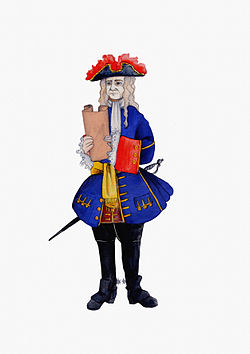 When we want to know what historical figures looked like before the invention of photography, we usually rely on paintings and engravings. However, these works are not always contemporary, and even when they are, they are often idealized representations. Historians compare visual information with historical documentation and formulate hypotheses about the appearance of historical figures. Illustrators can try to reconstruct the appearance of historical figures on the basis of these hypotheses. Antoni de Villarroel i Peláez (1656-1726) was a military commander in the service of the Habsburgs in the War of the Spanish Succession. As commander of the Army of Catalonia from 1713 to 1714, he organized the defense against the Siege of Barcelona. After the city fell, he was imprisoned by Philip V until his death. Very little is known about his appearance, except for the fact that he was more than 50 years old at the time of the siege. However, the Archive of the Crown of Aragon has a receipt for a uniform that Villarroel ordered in 1713. Naara Riveiro, a student at Serra i Abella in L'Hospitalet who was on internship at Amical Wikimedia, undertook the challenge of creating a hypothetical illustration of Villarroel. Roger Fuentes, Wikipedian-in-Residence at the Catalan History Museum, acted as her tutor, and the historian Francesc Xavier Hernàndez Cardona, of the Department of History Education at the University of Barcelona, was her subject-specific adviser. Naara and her advisers formulated the hypotheses that would allow her to represent Villarroel on the basis of historical knowledge. Naara created two images of Villarroel (standing and on horseback) wearing a three-cornered hat with red feathers and pale makeup—common characteristics for commanders of the period—as well as a dress uniform and equestrian boots. The appearance of his apparel—a blue dress uniform with red cuffs, the insignia of his regiment—was based on the existing documentation. The image of Villarroel on horseback depicts him during the last counterstrike that he led on September 11th, 1714 at Pla de'n Llull, during which he suffered an injury to his leg. Every detail of his clothing and equipment is based on historically verifiable information. The illustration was made with mixed media (watercolors and water-soluble pencils), and Photoshop was used to add the coat of arms. The images were scanned and uploaded to Wikipedia Commons. They are now used on Wikipedia in several languages to illustrate Villarroel's biography.
Portraits of 20th-century politicians Encyclopedias contain many biographies of important figures. On Wikipedia, biographies are usually accompanied by an "infobox" template on the right-hand side of the page that shows basic information about the person. The infobox template can be either generic or specific to the person's occupation (writer, musician, scientist, athlete, politician, etc.). The infobox allows an image of the person to be included so that readers can see what he or she looks like. For people who lived before the invention of photography, the image is usually a painting, engraving or modern historical reconstruction. For people who are still alive, the preferred option is to include a freely usable photograph. However, for people who died in the 20th century (or more recently), it can be difficult to find a freely usable photograph, either because the photographer (or his/her heirs) cannot be found or because they do not want to waive their rights to the photo. The English-language Wikipedia is the only one that uses copyrighted photographs (under the concept of "fair use"). However, the use of such photographs compromises the free reproduction of Wikipedia because the images have to be removed from any derivative works. Moreover, copyrighted photographs cannot be used in any of the other Wikipedias. To address this situation, wikiArS proposed having art students create portraits of 20th-century figures and make them freely available for use on Wikipedia. This task posed quite a challenge: the student would not be able to see the subject in person and would instead need to rely on photos and video recordings. However, it was also essential that the portrait not be considered a derivative work of any copyrighted documentation sources. Additionally, the portrait would obviously need to resemble the person in question. In short, the students would need to begin by making multiple sketches of the subject until they managed to capture his or her distinctive features. Only then would they be able to create a portrait that was not based on any existing image. To develop the assignments, we consulted with the Wikipedian community and looked at Wikipedia to see what images were needed. To simplify the documentation process, we drew up a list of related figures and allowed students to choose which portraits to draw based on the information they were able to find and their opinion of which faces would be easiest to draw. One image gap that we detected on Wikipedia was in the biographies of politicians who had served in the Catalan Government; some had photographs, whereas others did not. We decided to fill this gap by assigning the students to draw these politicians. During the 2011-2012 academic year, Bàrbara Domenech, an art student at Serra i Abella in L'Hospitalet who was on internship at Amical Wikimedia, created five portraits of politicians who had served in the Catalan Government after the end of the Franco dictatorship. All of the selected politicians were important figures in the Spanish transition to democracy. Some of them also went on to become important figures in European politics (for example, Antoni Gutiérrez Díaz served as Vice President of the European Parliament). During the following academic year (2012-2013), Diana Francitorra, an art student at Llotja in Barcelona who was on internship at Amical Wikimedia as well, followed in Bàrbara's footsteps. Diana made portraits of the two remaining now-deceased members of the transitional Catalan Government (Frederic Rahola and Joan Codina). She also drew three post-transitional members of the Catalan Government who were notable for their performance in office (or, in the case of Jordi Planasdemunt, for involvement in a major corruption scandal). Bàrbara had used a distinctive background texture in her portraits. Diana decided to use the same texture in order to lend a certain coherence to the collection of portraits, despite the two illustrators' different styles.
Animations using freely available 3D models  Thanks to the initiative of Manuel Palomo, a member of Wikimedia España affiliated with the Free Software Office (OSLUCA) at the University of Cádiz (UCA), and the collaboration of lecturer Lorena Gutiérrez, the UCA started collaborating with wikiArS during the 2012-2013 academic year. Students in the Multimedia and Animation Tools subject of the Bachelor's Degree in Advertising and Public Relations attended a seminar at which they were invited to create animations for concepts related to Wikipedia content. The students were offered two possibilities: 1) They could work under the guidance of an expert in architecture, enology, medicine, physical therapy, computer science, marine sciences, geophysics, magic or chemistry on the expert's choice of topic; or 2) They could propose a different topic, provided that they could find an expert adviser willing to work with them. After compiling documentation and getting advice from the expert advisers, the students drew up storyboards for their animation projects. A total of six students (Daniel Torres Sánchez, Manuel Jesús Arteaga Rico, Cristobal Sánchez Ruiz, Carlos Calvo Luna, Miguel Angel Rodríguez Vázquez and David Marín Sánchez) chose to make animations using Blender, a free 3D modeling and animation software program. The students had no experience with Blender, but the lecturer encouraged them to make the animation using 3D models available in free repositories, so they learned to use the program as they went along. They did not start completely from scratch: they searched for models with Wikipedia-compatible licenses that would be useful for the animation that they wanted to make. Using the materials they found and the storyboard they had developed, they adapted the animation script and got to work. They used animation techniques they had learned in class and consulted tutorials if they had doubts regarding specific aspects. When all else failed, they relied on the support of their lecturer. Once a week, the students filled in a rubric explaining the status of the project; this allowed their lecturer and advisers to track their progress. Drafts of the animations were sent to the expert advisers, who revised and corrected the students' work. They students also posted regular progress reports on social media and on a subject-specific forum.  Once the completed animations had been validated by the experts, they were posted on Wikimedia Commons in order to allow their use on Wikipedia and other open-knowledge projects. On the image-description page on Commons, the students posted the names of their advisers they had worked with. They also linked to the repositories where they had found the 3D models used in the animation and credited their authors. Because Commons does not allow Blender's native file format, the source files of the animations were posted on CommonsArchive.org, a repository designed specifically for source formats. The students then linked to this repository from the image-description page. The students’ animations are freely usable because they were created using free models. In addition, because the source files were made available, the animations can be reused by anyone who would like to make a new version. Any such new versions would, in turn, be considered derivative works of the students' animations, and would therefore remain in circulation as works that can be freely recombined. The academic year ended with an open seminar where the students presented their projects to their classmates and to students who would be taking the subject the following year.
Rekonstrui la Romian urbon Tarraco |


